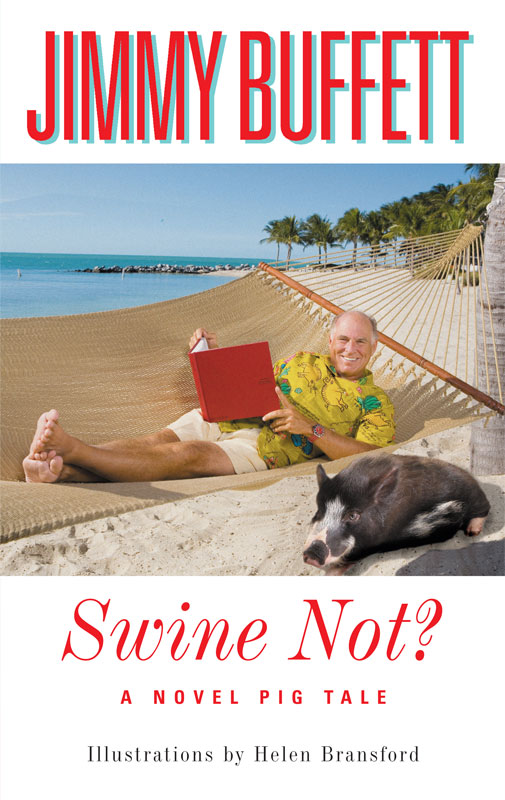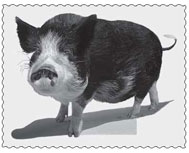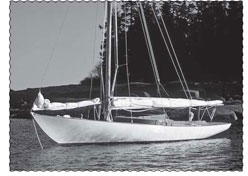Swine Not?


Copyright © 2008 by Jimmy Buffett
Illustrations © 2008 by Helen Bransford
All rights reserved. Except as permitted under the U.S. Copyright Act of 1976, no part of this publication may be reproduced, distributed, or transmitted in any form or by any means, or stored in a database or retrieval system, without the prior written permission of the publisher.
Little, Brown and Company
Hachette Book Group USA
237 Park Avenue, New York, NY 10017
Visit our Web site at
www.HachetteBookGroupUSA.com
First eBook Edition: May 2008
The characters and events in this book are fictitious. Any similarity to real persons, living or dead, is coincidental and not intended by the author.
Special thanks to Nina, Lynda Lou, Amy, Sunshine, Karen, Kathy, and Bonniet for shepherding me along through the whole pig-tale adventure. I couldn’t have done it without you. — J. B.
Photograph on page xiii by Benjamin Mendlowitz
Photograph on page xxi by Pamela Jones Photography
Photograph on page 16 by Julie Skarratt
ISBN: 978-0-316-03231-5
Contents
Chapter 3: Learning to Play the Angles
Chapter 4: Raising Humans Is Hard
Chapter 8: Ghosts in the Trees
Chapter 9: Uprooted Like Truffles
Chapter 10: Start Spreading the News
Chapter 15: Welcome to New York
Chapter 17: Traveling at the Speed of Dreams
Chapter 18: More Soccer than a Boy Could Want
Chapter 19: Not So Fast There, Rumpy
Chapter 20: An Unwanted Exotic
Chapter 22: My Four-Star Prison
Chapter 25: The Table Begins to Turn—What New Dog?
Chapter 26: That’s What Moms Are For
Chapter 27: A Pig in Sheepdog’s Clothing
Chapter 28: Cabin Fever in a Fish Tank
Chapter 29: A Prisoner of Plumbing
Chapter 30: There’s a Diva in the House
Chapter 31: A Roomful of Room Service
Chapter 32: A Pilot to the Rescue
Chapter 33: Something to Fit the Occasion
Chapter 35: Let Them Eat Pizza
Chapter 36: Blood Is Thicker than Cotton Candy
Chapter 37: Halloween Comes Early in New York
Chapter 38: I’m Not a Sausage—I’m an Animal
Chapter 40: Anteater on the Loose
Chapter 41: It’s Not the Avon Lady Calling
Chapter 42: Follow Those Pigeons
Chapter 43: An Unexpected Order
Chapter 45: A Taste of Show Business
Chapter 47: Always a Madridista
A
LSO BY
J
IMMY
B
UFFETT
A Salty Piece of Land
A Pirate Looks at Fifty
Where Is Joe Merchant?
Tales from Margaritaville
(A
ND FOR YOUNG READERS
)
The Jolly Mon
Trouble Dolls
F
OR
J
ANE
B
UFFETT, WHO KNOWS HOW TO PUT PEOPLE AND PIGS TOGETHER IN THE SAME PEN
Always remember,
a cat looks down on a man,
a dog looks up to a man,

but a pig will look a man
straight in the eye and see his equal.
— W
INSTON
C
HURCHILL

S
OMETIMES YOU
have to find the story, and sometimes the story finds you. In all my previous fiction, the stories were rooted in this nomad life I live. I converted my real-life experiences into fictional fun and made up a few more tales myself — always keeping a bit of mystery as to what was based on reality and what had sprung from my imagination. Faulkner said he was a liar by profession, and he made good money at it. However, in the case of Swine Not?, the story came to me.
One day our friend Helen Bransford brought over a manuscript she had written and some illustrations that went with it. She asked me to look at them. I knew the basic story, and everyone who knew Helen did, too. Her real-life story was this: Former Belle Meade debutante from Nashville, Tennessee, winds up marrying well-known author and moves into the Carlyle Hotel in Manhattan with her husband, twin kids, cats, and large pet pig — which she conceals from the management for two years. I had joined the chorus of Helen’s friends who had told her, “You have to write this stuff down.” When you’re a fiction writer, you sometimes simply can’t top the facts.
It is a unique and magical thing to read an original story for the first time, especially when what you are reading is good and, in my case, makes me laugh out loud. Those original twenty-five pages of text and the accompanying illustrations hooked me. The idea of a mom and two kids hiding a pig in a four-star hotel suite on the Upper East Side of Manhattan got me thinking. When I finished reading Helen’s story, I walked from the office to my house with a smile on my face. I told my wife, Jane, who had introduced me to Helen many years earlier, that this was one of the quirkiest and funniest stories I had read in a long time.
The next morning, just before sunrise, I made my cup of English breakfast tea and walked out of the silence of the house into the still-dark morning. My usual route was down to the dock to smell the sea, then up the oyster-shell driveway to my office to work. My job that morning, I thought, was to edit Helen’s story and give it back to her with my advice about where to get it published. That would take me into midmorning, and I would drop off the manuscript at her house on my way out to surf.
Lindbergh said, “We are of the stars,” and I believe and feel it and have always looked up to them for guidance, whether I was trying to find my way across the ocean or into the yet unwritten pages of a story. Standing at the water’s edge, I took in the view overhead of lingering planets and constellations still visible over the bay. My front yard, where the sea meets the sky, combined with the silence and the beauty of the natural world at that hour of the day, has long created a thinking spot. Sometimes there are things in a story or a song that need to be worked out. Other times I am just waiting to be struck by some invisible asteroid of inspiration. It is a good way to go to work, especially when you don’t really know what your job is.
Well, that morning, the stars did not directly do their inspirational thing, but instead they pointed me toward another source of thought. Sitting fifty yards off the beach was my little sailboat, High Cotton. She was a lovely and, some say, historic little gaff-rigged sloop that looked as good sitting at rest on a mooring line as she did under full sail. The sun was just beginning to light the sky to the east, and there was barely a whisper of breeze on the bay. I could hear the water, pushed by the incoming tide, lapping against her hull. As I sipped my tea and savored the moment, it suddenly happened. The stars had come through again. Staring at High Cotton, I heard a chord of familiarity ring out, and the universe connected the sailboat to Helen’s pig tale.
High Cotton was not a name I would have chosen for a boat, and it certainly didn’t fit the list of past vessels that I had christened. She had been someone else’s dream, and someone else had named her. Naming, and especially renaming, a boat is a very serious and superstitious undertaking. It would be like renaming your child. Somewhere back in the mythology of mariners, it was decreed that if you acquired a boat that had already been christened, you could rename it only once, and the moment to do that was immediately after you sailed her for the first time. If you did it any time after that moment, it was very bad luck, and nobody wants to sail on a bad-luck boat.
When I bought High Cotton, she had come with an incredible pedigree, having been designed by Nathanael Herreshoff as a Buzzards Bay 25 and having been built at the legendary Brooklin Boatyard in Maine by Joel White, master boatbuilder and son of E. B. White. In her first year, she had made herself an instant reputation as one of the fastest and most beautiful boats in New England, and had won prestigious races from Newport to Nantucket, but I had not bought her to race. All I was looking for in High Cotton was a beautiful single-handed boat that I could spend time in alone on the water. With all the other things that I find myself doing, I still just like being a sailor best, and sailing a boat alone is what a good sailor can do. High Cotton may not have been my original idea, but I could make her into that kind of boat and stay true to the designer’s original vision.
Staring at the boat that morning and listening to the stars, I realized that, like High Cotton, Helen’s pig tale was a treasure I had inherited. It had captured my attention and had gotten me thinking that there was more to the story. That is the way I felt about my little boat.
In its original form, Helen’s manuscript was totally entertaining and funny, but it also contained the potential for many characters and plots I was curious to explore. With Helen’s permission, I wanted to customize her boat. I called her later that morning and asked what she thought of my ideas. She laughed, and in the spirit of good fun, she let me loose; I was off and running to my imaginary shipyard.
I headed to the office, reread the manuscript, and started thinking about who and what I could add to the pig tale. It didn’t take long before I was working out new plotlines. My plan for the story was not to change course but to add some interesting stops on the journey. I was sailing into uncharted waters as far as pets were concerned. The only pets I have ever owned were dogs. I take that back. I did own a parrot for one day, but I returned it to the pet store after the parrot made it very clear to me and my valuable thumb and forefinger on my left hand that it did not desire to be part of my life. I knew nothing at all about pigs as pets. I was about to find out plenty, and now so are you.
There are many people out there who have funny stories to tell, but it’s the writing-it-down part that’s tricky. I can tell you that even though writing is a gift, it is not one that comes with a set of instructions or an autopilot. You wonder why a lot of writers go crazy, drink themselves to death, or become recluses? Because it is hard work! I know. I could never have guessed that this little piggy would end up taking more than two years to write, but I should have known from my experience with real voyages. As Billy Cruiser says in an earlier book, “The best navigators are not always certain where they are, but they are always aware of their uncertainty.” Longer-than-expected voyages come with the territory if you truly are a sailor. The journey can go on a lot longer than you expected.
As I said before, sometimes you look for the story, and sometimes it comes to you. So if you are asking yourself the question “What on earth is Jimmy doing writing a book about a pig instead of about boats, islands, bars, ballads, and beaches?” the answer is simple: “Swine Not?” I hope you enjoy this story.
— J
IMMY
B
UFFETT
N
OVEMBER 5, 2007
P
ALM
B
EACH
, F
LORIDA
